05 Dec 2018 - {{hitsCtrl.values.hits}}

 It is only a matter of seconds to take someone’s life. A life so precious, so dearly brought up. Violence among youth has been a social issue that has emerged over the recent past. The advent of technology, accessibility to violence and triggers in the immediate environment are possible causative factors. Several incidents of violence among youth were reported during the last two weeks.
It is only a matter of seconds to take someone’s life. A life so precious, so dearly brought up. Violence among youth has been a social issue that has emerged over the recent past. The advent of technology, accessibility to violence and triggers in the immediate environment are possible causative factors. Several incidents of violence among youth were reported during the last two weeks.
One was a CCTV footage of a youth being stabbed in Matara and the other a video of a group of youth recording a girl being strangled to death. As much as it is important to educate future generations, it is also important to inculcate moral values within them.
Against this backdrop, Daily Miror took a closer look at why youth are resorting to violence and what needs to be done to prevent crime.
November 21: A school prefect in his A/Levels (maths stream) who got into a brawl with a Grade 9 student after the latter took umbrage at being disciplined by a 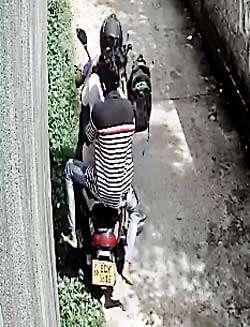 senior, succumbed to his injuries. The incident took place at a leading school in Dinagoda, Beruwala. The dispute had arisen because the younger student ignored the bell rung by the prefect to get everyone to be silent in class. This triggered an argument which ended with the prefect being shoved backwards by the Grade 9 student causing him to collapse and hit his head on the floor.
senior, succumbed to his injuries. The incident took place at a leading school in Dinagoda, Beruwala. The dispute had arisen because the younger student ignored the bell rung by the prefect to get everyone to be silent in class. This triggered an argument which ended with the prefect being shoved backwards by the Grade 9 student causing him to collapse and hit his head on the floor.
The victim, Mohamed Thariq, who complained that he was not feeling well, was admitted to the Beruwala Hospital and subsequently transferred to the Nagoda Hospital in critical condition. He was then transferred to the Colombo National Hospital only to breathe his last on November 27. According to hospital officials, Thariq had suffered a brain injury.
November 24: 19-year-old Rasindu Gimhana was stabbed to death while on his way to a tuition class. The tragedy took place at Alevella Street in Matara. The 17-year-old student who stabbed him had claimed that Rasindu’s brother has had an argument with his girlfriend. As a result, he was compelled to stab Rasindu -- a resident of Naimbala who was preparing to sit for his A/L exam next year. The main suspect and two others were arrested in connection with this crime and further investigations are being carried out.
November 25: 22-year-old Shiromi Priyadarshani was strangled to death by her boyfriend following a heated argument between the duo over a clandestine affair the girl had. Her body was found near Sumeda Tank in Magandanamulla, Monaragala. Shiromi had been working at a beauty parlour owned by the suspect’s sister. The suspect, who is a resident of Raththanapitiya in Weliyaya, had already been arrested and produced in the Monaragala Magistrate’s Court. Giving a new twist to the story, a group of youth had videoed the incident and released it on social media. The Monaragala Police are carrying out investigations to trace them.
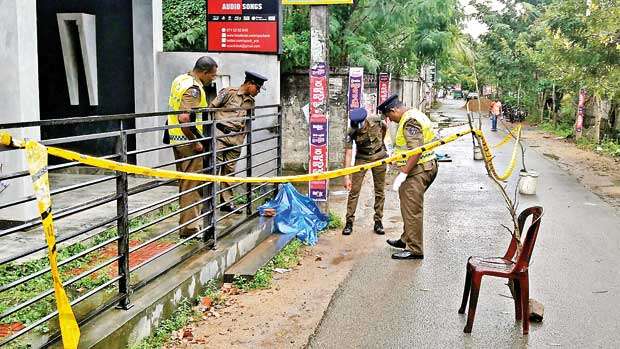
November 26: A 22-year-old fruit vendor was killed after he was stabbed with a broken glass bottle by a fellow vendor in Pettah. The suspect had stabbed Kumara Dickson (22) when he had asked to repay the money the suspect owed him.
The Pettah Police are carrying out investigations to arrest the missing suspect who is said to be a resident of Kotahena.
19-year-old Rasindu Gimhana was stabbed to death while on his way to a tuition class. The tragedy took place at Alevella Street in Matara. The 17-year-old student who stabbed him had claimed that Rasindu’s brother has had an argument with his girlfriend
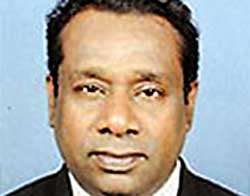 “There existed a strong social bond among people, but we don’t see it anymore,” said W.M. Dhanapala, Professor of Criminology at Sri Jayewardenepura University. “There was a bond between the family, relatives and even the community. But over the recent past, we have seen these bonds being disrupted. A social bond is important to protect law-abiding behaviours. When moving out of the family, there is a bond among the neighbours and the community you live in.”
“There existed a strong social bond among people, but we don’t see it anymore,” said W.M. Dhanapala, Professor of Criminology at Sri Jayewardenepura University. “There was a bond between the family, relatives and even the community. But over the recent past, we have seen these bonds being disrupted. A social bond is important to protect law-abiding behaviours. When moving out of the family, there is a bond among the neighbours and the community you live in.”
“The bond that existed between relatives and neighbours brought about a control in the community,” he continued. “But today we see new people settling in villages and the community is not integrated anymore. Hence, there is no control in the community as well. Although violent elements existed, they were never exposed owing to community control. But today, we witness a disconnection and violent elements lead to crimes. In schools, teachers were responsible in inculcating discipline among children. But with circulars going round to end corporal punishment, the teacher’s responsibility was weakened. This doesn’t mean I support corporal punishment, but today, teachers don’t even advise children to do the right thing. They are more interested in exam results. Back in the day, children feared teachers and had more respect, but today we hardly see that happening in schools.”
Prof. Dhanapala further said deterrence was vital. “If not, people will take things for granted similarly to what we see today. The family also doesn’t consider social 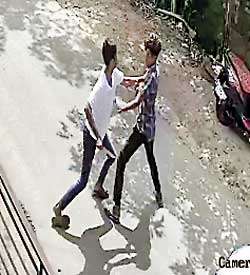 values. In school, there is no value-based education system but more of an exam-oriented knowledge culture. At home, both parents are employed and they don’t have time to spend with their children.”
values. In school, there is no value-based education system but more of an exam-oriented knowledge culture. At home, both parents are employed and they don’t have time to spend with their children.”
When 22-year-old Shiromi Priyadarshani was being strangled to death, a group of youth decided to video the incident without taking action. “We also see that the community doesn’t seem to take any responsibility when crimes take place,” Prof. Dhanapala added. “Hence, they resort to videoing the event and uploading it on social media, causing further damage. The society needs a revival. It is important for a society to glue rather than taking on individual roles. In countries such as the United States, crime rate is high as a result of individualisation. There has to be strong communication among family members and children should have people whom they place trust in.”
“Since private education wasn’t regulated, we saw the boom in tuition classes,” Prof. Dhanapala said. “These are causative factors that contribute to the increase in crime rate.
A tuition master is not bothered about values. He wants his students to secure island rankings so that he could grab more students to augment his income. These processes need to be streamlined. On the other hand, when we look at news reports, sometimes they are extremely exaggerated. Irrespective of the severity of the crime, the media also increases the magnitude of seriousness by screening it on repeat. The media has a huge responsibility in terms of reporting crimes as it also comes with a social responsibility. Thus, it is important that both electronic and print media personnel be trained before reporting or publishing incidents related to crime.
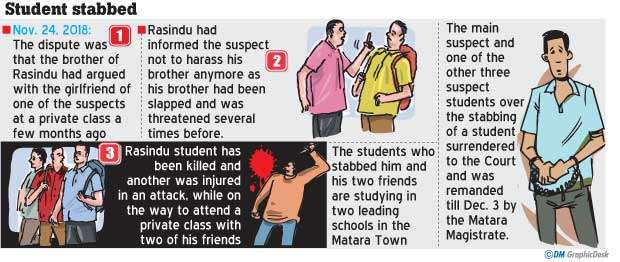
By showing incidents such as youth killing each other, there is a greater tendency of hinting an idea to another person to do the same. People should start respecting human life. A crime could only be prevented as it has no cure. Therefore, social values and responsibilities have to be inculcated in the minds of the people.”
22-year-old Shiromi Priyadarshani was strangled to death by her boyfriend following a heated argument between the duo over a clandestine affair the girl had. Her body was found near Sumeda Tank in Monaragala
 “Violence among youth is a serious issue the World Health Organisation (WHO) has given guidelines on,” said Dr. Udena Atygalle, Consultant Child and Adolescent Psychiatrist at Karapitiya Teaching Hospital. “There’s no single reason as to why it happens but it’s a result of several causative factors. These could be factors related to the individual or family. Some of these include alcohol intake, limited education and even psychological disorders. Exposure to violence is another trigger. If there is violence in the family, chances are that the youth will follow suit. We should also look at access to violence, like where individuals get arms from.”
“Violence among youth is a serious issue the World Health Organisation (WHO) has given guidelines on,” said Dr. Udena Atygalle, Consultant Child and Adolescent Psychiatrist at Karapitiya Teaching Hospital. “There’s no single reason as to why it happens but it’s a result of several causative factors. These could be factors related to the individual or family. Some of these include alcohol intake, limited education and even psychological disorders. Exposure to violence is another trigger. If there is violence in the family, chances are that the youth will follow suit. We should also look at access to violence, like where individuals get arms from.”
He said adults should reduce risk factors. “This includes teaching life skills and at home parents should have regular conversations with their children and discuss how to deal with situations without resorting to violence. Lack of communication is another issue why children behave violently. Schools can have policies on discrimination and conduct bullying prevention programmes. Parents can also extend their support to such initiatives. It is important to build a family network of support as it plays a pivotal role in the early identification of problems.”
30 Nov 2024 12 minute ago
30 Nov 2024 2 hours ago
30 Nov 2024 5 hours ago
30 Nov 2024 6 hours ago
30 Nov 2024 9 hours ago